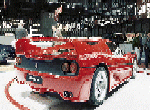FERRARI - 1995
F50

 When the first converted and road-legal Porsche 962s appeared in the streets
something radically changed in the way cars are build. Yes, we all know there
were racers transformed into street cars due to race regulations. But who'd
ever think 'bout turning a 400+ km/h fast vehicle into a street machine? Well
here is a list for You: from Germany Zimmermann, Koenig Sportscars and Dauer
Racing and in the UK Schuppan Racing. Now, Ferrari went one step further:
took a Formula 1 racer and built a road-going roadster based on it. The
Ferrari F50 was first officially introduced at the 1995 Geneva Motorshow
twice. First, there was a press conference at the newly opened Geneva
Automuseum and next day, on the first the press day at the Ferrari
stand, they held another. This car was one of the biggest showstopper in 1995.
When the first converted and road-legal Porsche 962s appeared in the streets
something radically changed in the way cars are build. Yes, we all know there
were racers transformed into street cars due to race regulations. But who'd
ever think 'bout turning a 400+ km/h fast vehicle into a street machine? Well
here is a list for You: from Germany Zimmermann, Koenig Sportscars and Dauer
Racing and in the UK Schuppan Racing. Now, Ferrari went one step further:
took a Formula 1 racer and built a road-going roadster based on it. The
Ferrari F50 was first officially introduced at the 1995 Geneva Motorshow
twice. First, there was a press conference at the newly opened Geneva
Automuseum and next day, on the first the press day at the Ferrari
stand, they held another. This car was one of the biggest showstopper in 1995.
The idea came from the 2nd son of Enzo Ferrari, Piero. After the F40
he wanted to see a Ferrari on a market made from a Formula 1 racer. The
starting point was Prost's 1990 641/2 rocket.
 It's 3.5 litre engine was very
compact, very short so it was not too difficult to fit in the rear without
making the wheelbase too long. This five-valve per culinder engine is
naturally aspirated engine (the F40 has had a turbo engine).
It's 3.5 litre engine was very
compact, very short so it was not too difficult to fit in the rear without
making the wheelbase too long. This five-valve per culinder engine is
naturally aspirated engine (the F40 has had a turbo engine).
The body was designed by Pininfarina, who designed the whole current Ferrari
range. Cues were taken from the Mythous prototype of 1989. CAD and normal
methods were combined and after various proposals the final result emerged.
The final styling model was completed in 1991. Although it looks all but
identical to the production car, three important modifications were done: 1. enlargement
of the front air intakes, 2. a small spoiler has been placed under the front
bumper, 3. addition of two small wings to the A-pillar. The final shape with
a Cd factor of 0.372 looks breathtaking. It's everything a Ferrari should be:
flowin' lines, wideness and wildness. There are two versions: hood on/off.
There is big road noise due to the fact that F1 technology lies underneath.
But then You'll surely know You HAVE F1 technology under Your pants.
 exploited view from the press release
exploited view from the press release
349
F50s will be built (interestingly one laess than the McLaren F1's originally
planned build run).
The first 50 are heading for the States to avoid the tougher regulations,
January 1996. The price tag is 475.000 US dollars or 329.000 British pounds.
So it costs half of the McLaren F1 but this car is not a competitor of the
F1. Why 349? Ferrari figured out 350 cars'd be fine and then came the respect
of Enzo who thought it's good business always to build one less car than the
market wanted. Rumours are circulatin' about a F60.
Technical details
| Engine
|
|---|
| Configuration
| 12 cylinders in 65 degree V layout
|
|---|
| Bore
| 85 mm
|
|---|
| Stroke
| 69 mm
|
|---|
| Cylinder capacity
| 23.9 cu in (3916 cc)
|
|---|
| Total displacement
| 286.7 cu in (4700 cc)
|
|---|
| Compression ratio
| 11.3:1
|
|---|
| Max. power output
| 382.5 kW (513 HP SAE, 520 CV CE) at 8500 rpm.
|
|---|
| Peak torque
| 417 Nm (347 lb ft) at 6500 rpm
|
|---|
| Specific power
| 109 HP/litre (SAE)
|
|---|
| Ignition
| Bosch static electronic ignition
|
|---|
| Injection
| Bosch Motronic 2.7 injection
|
|---|
| Engine weight
| 198 kg (436.5 lb)
|
|---|
| Performance
|
|---|
| Top Speed
| 325 km/h (202 mph)
|
|---|
| Acceleration
| 0 to 60 mile 3.7 s (0-100 km/h 3.87 s)
| 1 mile: 30.3 s (0-1000 m 21.7 s)
|
|---|
| Dimensions and weights
|
|---|
| Max. length
| 176.4 in (4480 mm)
|
|---|
| Max. width
| 78.2 in (1986 mm)
|
|---|
| Max. height
| 44.1 in (1120 mm)
|
|---|
| Wheelbase
| 101.6 in (2580 mm)
|
|---|
| Front track
| 63.8 in (1620 mm)
|
|---|
| Rear track
| 63.1 in (1602 mm)
|
|---|
| Weight unladen
| 2712 lb (1230 kg)
|
|---|
| Tyres
| Tubeless radial tyres
Front: 245/35 ZR 18
Rear: 335/30 ZR 18
|
|---|
| Rubber fuel tank
| capacity 27.7 US. gal/ 32.1 Imp. gal (105 liter)
|
|---|
| Front brake discs
| 14 in (355 mm)
|
|---|
| Rear brake discs
| 13.2 in (335 mm)
|
|---|
Equipment

| Air conditioning, Detachable hard-top/ open-top section with
roll bats, including trolley and stowage bag, documented photo album showing
car in build, choice of pedal box sets - one up to shoe size 7, and one above
size 7, tailor-made raing boots with owner's initials.
|
|---|
100 people already stopped lookin' for a way to find out how Alain Prost
felt himself in 1990 (in other words: 100 orders have been placed to the
F50 up to date).
F355 Spider




"Who said a spider couldn't fly" - this slogan was applied way back to a
particular Aston Martin 2-seater, but it fits to this one either.
This car is set to be the biggest selling F355. Why? The prancing horse
often associated with the open-top motoring. This car ain't a targa or any
stuff like that, it's 100 % open Ferrari.
It's based on the GT's variable section welded steel tube spaceframe chassis
but modified to retain as much of the 355's torsional stiffness and to
accomodate the power hood's six electric/ hydraulic motors. So only a switch
is required to raise the top which is then fastened manually to the top of the
windshield. The body modifications are: rear wings, roof and B-pillars. "Any
performance penalty caused by added weight is undetectable. And the wonderful
handling has not been spoiled by any lack of rigidity" stated Paul Frere in
R&T.
 As with all F355s shipped to America, dual airbags are standard. Inside the
car there are such nice touches like the adjustable steering column, Conolly
leather upholstered seats. The car weighs about 130 lbs more than the coupe.
Most Spiders are destined for the Californian market. But as Luca di
Montezumolo, the president of Ferrari said: Ferrari is not a mass manufacturer
and has pinned maximum annual production to 3000 cars a year. That means you
might have to wait 18 months for your Spyder, even if you order one now.
As with all F355s shipped to America, dual airbags are standard. Inside the
car there are such nice touches like the adjustable steering column, Conolly
leather upholstered seats. The car weighs about 130 lbs more than the coupe.
Most Spiders are destined for the Californian market. But as Luca di
Montezumolo, the president of Ferrari said: Ferrari is not a mass manufacturer
and has pinned maximum annual production to 3000 cars a year. That means you
might have to wait 18 months for your Spyder, even if you order one now.
Technical details
Engine

|
|---|
|
|
|---|
| Configuration
| 8-cylinder in V90 degree in the middle with rear-wheel drive
|
|---|
| Capacity
| 3496 cc (213.3 cu. in.)
|
|---|
| Bore x stroke
| 85 x 77 mm (3.35 x 3.03 in).
|
|---|
| Max. power
| 280 kW (375 HP) @ 8250 rpm
|
|---|
| Max torque
| 363 Nm (269 lb. ft) @ 6000 rpm
|
|---|
Dimensions and weights

|
|---|
| Length
| 4250 mm (167. 3 in)
|
|---|
| Width
| 1900 mm (74.8 in)
|
|---|
| Height
| 1170 mm (46.1 in)
|
|---|
| Wheelbase
| 2450 mm (96.5 in)
|
|---|
| Kerb weight
| 1350 kg (2976 lb)
|
|---|
| Tyres
| 255/40 ZR 18 (front)
265/40 ZR 18 (rear)
|
|---|
| Performance
|
|---|
| Max. speed
| 295 km/h (183 mph)
|
|---|
| Acceleration to 0-100 km/h
| 4.7 sec (0-60 mph 4.6 sec).
|
|---|
Go back to the exotics page !
Go back to the main page!
Copyright January, 1996.
Paul Negyesi
I'm no way related to the companies or their
products. I have no responsibility for the accuracy of the above info.
This document or parts of it cannot be used for commercial purposes.

 When the first converted and road-legal Porsche 962s appeared in the streets
something radically changed in the way cars are build. Yes, we all know there
were racers transformed into street cars due to race regulations. But who'd
ever think 'bout turning a 400+ km/h fast vehicle into a street machine? Well
here is a list for You: from Germany Zimmermann, Koenig Sportscars and Dauer
Racing and in the UK Schuppan Racing. Now, Ferrari went one step further:
took a Formula 1 racer and built a road-going roadster based on it. The
Ferrari F50 was first officially introduced at the 1995 Geneva Motorshow
twice. First, there was a press conference at the newly opened Geneva
Automuseum and next day, on the first the press day at the Ferrari
stand, they held another. This car was one of the biggest showstopper in 1995.
When the first converted and road-legal Porsche 962s appeared in the streets
something radically changed in the way cars are build. Yes, we all know there
were racers transformed into street cars due to race regulations. But who'd
ever think 'bout turning a 400+ km/h fast vehicle into a street machine? Well
here is a list for You: from Germany Zimmermann, Koenig Sportscars and Dauer
Racing and in the UK Schuppan Racing. Now, Ferrari went one step further:
took a Formula 1 racer and built a road-going roadster based on it. The
Ferrari F50 was first officially introduced at the 1995 Geneva Motorshow
twice. First, there was a press conference at the newly opened Geneva
Automuseum and next day, on the first the press day at the Ferrari
stand, they held another. This car was one of the biggest showstopper in 1995.
 It's 3.5 litre engine was very
compact, very short so it was not too difficult to fit in the rear without
making the wheelbase too long. This five-valve per culinder engine is
naturally aspirated engine (the F40 has had a turbo engine).
It's 3.5 litre engine was very
compact, very short so it was not too difficult to fit in the rear without
making the wheelbase too long. This five-valve per culinder engine is
naturally aspirated engine (the F40 has had a turbo engine).
 exploited view from the press release
exploited view from the press release







